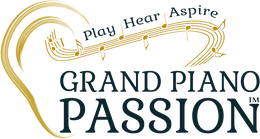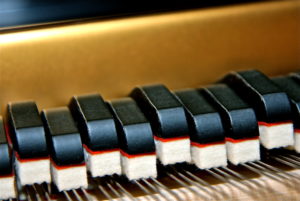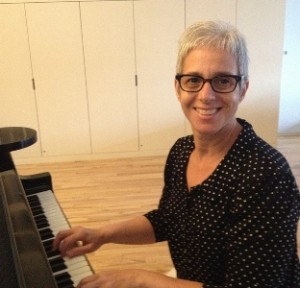The piano duet pair Anna Shelest and Dmitri Shelest first met at the Kharkiv Special Music School in Ukraine when they were 12 years old. They fell in love later, after they both had moved to the United States and found themselves as two fellow Ukrainian pianists making a new life in a different country. Recently, this husband and wife team extended their partnership to the piano, where they perform classical piano duets for four hands, one piano. Earlier this year at the ABC Gala at Carnegie Hall, they debuted Ravel’s La Valse, their interpretation electrifying and suspenseful.
In this exclusive interview for GRAND PIANO PASSION™, Anna Shelest and Dmitri Shelest share their experiences with piano duets for adult piano students.
So you both moved to the United States in 2000, and then you married seven years later, is that right?
Anna: We actually had two weddings. Legally we got married in March 2007 in the U.S., but since all of our family lives in Ukraine, we also celebrated our wedding in our hometown of Kharhov in July 2007.
How does being married affect your collaboration on piano duets?
Dmitri: I find that being married simplifies our collaboration. If Anna hears that my left hand is uneven, she will tell me to fix it, without having to worry about insulting my self-esteem. When we talk about interpretation, we are not afraid to voice our opinions. If I don’t agree with Anna, I won’t have to go through a long process of praising her idea and then carefully telling her that I might disagree. This seems to save a lot of time and get to the right thing faster.
Anna: In duo playing, you want to bring the strongest aspects of both partners forward as much as possible. Because we grew up together as musicians, we really know each other’s playing, and we have a good understanding of each other’s strengths. Sometimes we go back and forth, testing different interpretations, so at the end it is hard to recall who originated each idea in the first place.
by Anna Shelest
This dazzling poème chorégraphique pour orchestre was conceived as a ballet commissioned by the founder of the Ballets Russes, Sergei Diaghilev. However, after first hearing the work in a two-piano version, Diaghilev said that it was a “not a ballet. It is a portrait of ballet”—a comment that effectively ended the relationship between the two. La Valse, written shortly after World War I, has resemblances to the great Strauss waltzes, yet with a clear statement on where the new music is headed, especially with its harmonic developments. It begins with a conception-like vagueness of a waltz and ends with nearly destroying the form.
Does being married affect how you perform together?
Anna: I feel that it is important to leave some room for spontaneity during the performance. The longer we play a certain piece, the more freedom we have to go with the moment without losing each other. I am also not a big fan of talking too much in rehearsal. After you play a few times together, your ears should tell you all you need to know. Being married helps us to work well together, although I feel all duos need to have an element of spontaneity.
And when you perform, you’ve made the decision to play piano duets with one piano, four hands?
Dmitri: Yes. Not many venues have two good pianos on stage, and both of us think, especially Anna, that two pianos might be a little too much. If you add another piano, you won’t necessarily gain more colors, just volume. Noise happens. At first it seems easier to perform on two pianos rather than having to share one keyboard. And it is easier for the composer who arranges the music not to have to worry about how to distribute the middle register of the keyboard for two people. But once you get past some of these inconveniences, it becomes much easier to anticipate what your partner is about to do.
Your playing of the La Valse piece in the video above is wonderful—fiery, intimate. How did you come to select La Valse as a keystone of your repertoire?
Anna: We are interested in pieces that are originally orchestral but work well on the piano too. Most of our repertoire has been arranged for one piano, four hands, by the original composers themselves. In fact, some of the pieces, like the Schubert Fantasy for piano four hands, were originally written for four hands. We grew up playing a lot of big, virtuosic pieces as soloists, so it is something that is very much part of our musical identity. La Valse fits in with our approach.
That’s interesting. How do you address the challenge of creating a full orchestral sound on one piano?
Anna: My philosophy is to approach pieces like La Valse on the piano not as an orchestra reduction but rather as a virtuosic piano showpiece.
[list][li type=”icon-caret-right”]Les Preludes, Liszt[/li]
[li type=”icon-caret-right”]The Moldau from Má vlast, Smetana[/li]
[li]Rhapsody in Blue, Gershwin[/li]
[li]Fantasy in F minor D.940, Schubert[/li]
[li]Symphony No. 6, Third Movement, Tchaikovsky[/li]
[li]6 Morceaux, Op. 11, Rachmaninoff[/li]
[li]Scherzo from A Midsummer Night’s Dream, Mendelssohn[/li]
Dmitri: When we were working on La Valse, sometimes I found myself going too far in trying to imitate the sound of an orchestra or a particular instrument. While Anna totally agrees about the orchestral nature of the piece, she cleared up my head by reminding me that this is the piano and some things just won’t sound the same. Trying to imitate an orchestral instrument in a certain passage creates a sound that is pale, but if you take advantage of the properties of the piano, you bring out more color.
That is great advice, applicable also to piano solos arranged from originally orchestral pieces. What other advice do you have for adult piano students interested in playing duets for one piano, four hands?
Anna: My main advice would be to listen a lot before you talk. Think first of what you could have done better before giving your partner any feedback or criticism. It can feel awkward to share a keyboard with someone else, almost as though that person is invading your personal space, so you have to consider that your partner might have the same feelings.
Dmitri: I agree. I think most people at first feel uncomfortable sitting down at the piano and having to consider someone else, be it a violinist, singer or another pianist. And it is an additional workload having to constantly follow and listen to someone else’s part. But as always, with more experience comes more pleasure. Team collaboration is different than solo performing, but in many ways, for me at least, equally satisfying.




0 Comments